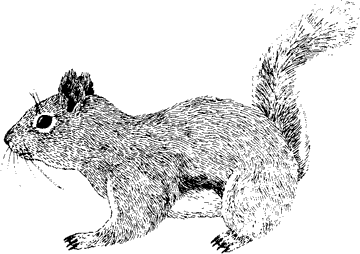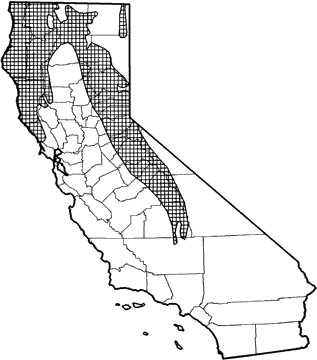
Douglas Squirrel
Distribution, Abundance, and Seasonality
Common, yearlong resident of conifer, hardwood-conifer, and riparian habitats of the Sierra Nevada, Cascade, Klamath, North Coast, and Warner Ranges. Occurs from sea level to 3333 m (0-11,000 ft).

Range Map
Specific Habitat Requirements
Feeding: Douglas' squirrels are omnivorous. They eat primarily conifer seeds and fungi. They also consume pollen cones and cambium of conifers, mast, twigs, sap, leaves, buds, and occasionally arthropods, bird eggs, and nestlings. They forage in trees and on the ground. Food is cached, often in large caches, for winter use. These caches are located in moist places in trees, or under logs, stumps, rocks, or litter. Individuals may tunnel under snow to reach caches.
Cover: Cover is provided by mature trees with substantial crown closure. They tend to avoid areas with considerable shrub understory.
Reproduction: Douglas' squirrels breed in mature conifer stands. Nests are located in cavities in trees and snags, often old woodpecker nests, or occasionally in rock cavities. They line their nest with grass and shredded bark. If cavities are not available, they may build a nest of grass, twigs, leaves, or moss in the branches of a tree.
Water: Probably meet water needs from the food they consume.
Pattern: Uses medium-sized stands of intermediate to mature conifer habitats, containing tree/shrub ecotones, substantial canopy closure, large trees and snags with cavities, and adjacent riparian areas. In the Blue Mts. of Oregon, the minimum amount of habitat required per population was estimated to be about 259 ha (640 ac) (Thomas 1979). Large trees and snags required.
Species Life History
Activity Patterns: Yearlong diurnal activity, but usually remain in nests during winter storms and cold weather (Maser et al. 1981).
Seasonal Movements / Migration: Non-migratory.
Home Range: Home range and territory coincide (Smith 1968). Good habitat supports densities approaching 2/ha (2.5 ac).
Territory: In the Cascades of southern British Columbia, Smith (1968) found that territories held by females averaged 0.62 ha (1.5 ac), and ranged from 0.4 to 0.8 ha (0.9 to 2.0 ac). Douglas' squirrels defend food caches, especially in winter.
Reproduction: The majority of males are reproductively active March to May; some are active from December through August. Gestation lasts 36-40 days; most young are born in May and June; some from February to September. Litter size averages 4-5 (range 1-9). One litter per yr usually, occasionally 2, depending on date of birth of female and size of the cone crop. Weaning occurs in October, although female and young may remain together through December.
Niche: Predators include martens, bobcats, longtailed weasels, foxes, coyotes, goshawks, and great horned owls. Douglas' squirrels are extremely quick and agile arboreal inhabitants of coniferous forests of the west coast of the U.S. Potentially compete with many other seed-eating species.
Sources & References
California Department of Fish and Game, 1999.
California's Wildlife, Sacramento, CA.
Written by: T. Harvey, reviewed by: M. White, edited by: G. Ahlborn
Hartesveldt, R. J., H. T. Harvey, H. S. Shellhammer, and R. E. Stecker. 1970. Giant Sequoia ecology. USDI, Nat. Park Serv., San Francisco. Final Rep. Contract No. 14-10-0434-3364. 48pp.
Ingles, L. G. 1965. Mammals of the Pacific states. Stanford Univ. Press, Stanford, CA. 506pp.
Maser, C., B. R. Mate, J. F. Franklin, and C. T. Dyrness. 1981. Natural history of Oregon coast mammals. Pac. Northwest For. And Range Exp. Sta., USDA, For. Serv., Gen. Tech. Rep., PNW-133. 496pp. Smith, C. C. 1968. The adaptive nature of social organization in the genus of tree squirrels, Tamiasciurus. Ecol. Monogr. 38:31-63. Smith, C. C. 1970. The coevolution of pine squirrels (Tamiasciurus) and conifers. Ecol. Monogr. 40:349-371. Thomas, J. W., ed. 1979. Wildlife habitats in managed forests: the Blue Mountains of Oregon and Washington. USDA, For. Serv., Agric. Handb. No. 553. 512pp. Woods, J. B. 1957. Gowack - the cone picker. Amer. For. 63:53-58.
California Animal Facts | California's Wildlife